历史
Main article: History of the University of Florida
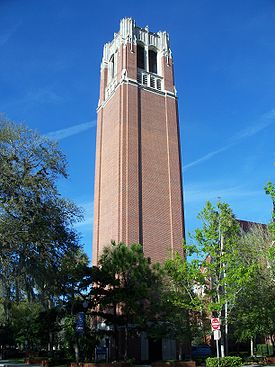
Century Tower, begun in 1953, to commemorate the 100th anniversary of the founding of university and as a tribute to the alumni who perished in both World War I and World War II.
The University of Florida traces its origins to 1853, when the East Florida Seminary, one of the University of Florida's four predecessor institutions, was founded in Ocala, Florida.
On January 6, 1853, Florida Governor Thomas Brown signed a bill that provided public support for higher education in the state of Florida. Gilbert Kingsbury was the first person to take advantage of the legislation, and established the East Florida Seminary. The East Florida Seminary was the first state-supported institution of higher learning in Florida. James Henry Roper, an educator from North Carolina and a state senator from Alachua County, built a school, the Gainesville Academy, around the same time. In 1866, after East Florida Seminary had closed during the American Civil War, Roper offered his land and school to the State of Florida in exchange for the relocation of East Florida Seminary to Gainesville.
The second major precursor to the University of Florida was the Florida Agricultural College, established at Lake City by Jordan Probst in 1884. Florida Agricultural College became the state's first land-grant college under the Morrill Act. In 1903, the Florida Legislature, desiring to expand the school's outlook and curriculum beyond its agricultural and engineering origins, changed the name of Florida Agricultural College to the "University of Florida," a name that the school would hold for only two years.
"University of the State of Florida"
In 1905, the Buckman Act consolidated the colleges of the state. The member of the Florida Legislature who wrote the act, Henry Holland Buckman, is the namesake of Buckman Hall, one of the university's oldest buildings. The Buckman Act reorganized the State University System of Florida and empowered the Florida Board of Control to govern the system. The Act also mandated the merger of four pre-existing state-supported institutions into the new University of the State of Florida----the University of Florida at Lake City (formerly Florida Agricultural College) in Lake City, the East Florida Seminary in Gainesville, the St. Petersburg Normal and Industrial School in St. Petersburg, and the South Florida Military College in Bartow.
The Buckman Act also consolidated the colleges and schools into three institutions segregated by race and sex—the University of the State of Florida for white men, the Florida Female College for white women, and the State Normal School for Colored Students for African-American men and women.
On July 6, 1905, the Board of Control selected Gainesville for the new university campus. Andrew Sledd, president of the pre-existing University of Florida at Lake City, was selected to be the first president of the new University of the State of Florida. The 1905-1906 academic year was a year of transition; the new University of the State of Florida was legally created, but operated on the campus of the old University of Florida in Lake City until the buildings on the new campus in Gainesville were completed. Architect William A. Edwards designed the first official campus buildings in the Collegiate Gothic style. Classes began on new Gainesville campus on September 26, 1906 with 102 students.
In 1909, the name of the school was officially simplified from the "University of the State of Florida" to the "University of Florida."
The alligator was incidentally chosen as the school mascot in 1911, after a local vendor ordered and sold school pennants with an alligator imprinted on them. The school colors, orange and blue, are believed to be derived from the blue and white school colors of the University of Florida at Lake City and the orange and black colors of the East Florida Seminary at Gainesville.
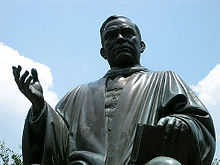
Statue of Albert Murphree, the second president of the university.
College reorganization
In 1909, Albert Murphree was appointed the second president of the university, and organized several of the colleges of the university, increased enrollment from under 200 to over 2,000, and he was instrumental in the founding of the Florida Blue Key leadership society. Murphree is the only University of Florida president honored with a statue on the campus.
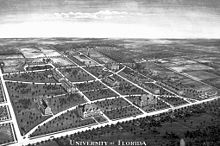
The University of Florida campus in 1916, looking southwest.
In 1924, the Florida Legislature mandated that women of a "mature age" (at least twenty-one years old) who had completed sixty semester hours from a "reputable educational institution" would be allowed to enroll during regular semesters at the University of Florida in programs that were unavailable at Florida State College for Women. Before this, only the summer semester was coeducational, to accommodate women teachers who wanted to further their education during the summer break. Lassie Goodbread-Black from Lake City became the first woman to enroll at the University of Florida, in the College of Agriculture in 1925.
John J. Tigert became the third university president in 1928. Disgusted by the under-the-table payments being made by universities to athletes, Tigert established the grant-in-aid athletic scholarship program in the early 1930s, which was the genesis of the modern athletic scholarship plan that is currently being used by the National Collegiate Athletic Association.
Post World War II
Beginning in 1946, there was dramatically increased interest among male applicants who wanted to attend the University of Florida, mostly returning World War II veterans who could attend college under the GI Bill of Rights (Servicemen's Readjustment Act). Unable to immediately accommodate this increased demand, the Florida Board of Control opened the Tallahassee Branch of the University of Florida on the campus of Florida State College for Women in Tallahassee. By the end of the 1946-1947 school year, 954 men were enrolled at the Tallahassee Branch. The following semester, the Florida Legislature returned the Florida State College for Women to coeducational status and renamed it Florida State University. This sequence of events also opened up all of the colleges that comprise the University of Florida to female students. African-American students were allowed to enroll starting in 1958. Shands Hospital first opened in 1958 along with the medical school. Rapid campus expansion began in the 1950s and continues to the present day.
National & international prominence
In 1985, the University of Florida was invited to become a member of the Association of American Universities (AAU), an organization composed of sixty-two academically prominent public and private research universities in the United States and Canada. Florida is one of only seventeen public, land-grant universities that belong to the AAU. In 2009, President Bernie Machen and the University of Florida Board of Trustees announced a major policy transition for the university. The Board of Trustees supported the reduction in the number of undergraduates and the shift of financial and other academic resources to graduate education and research in the future.
The University of Florida has continued to rise in the U.S. News & World Report college and university rankings. In 2001, Florida was labeled a Public Ivy and was second in Kiplinger's 2009 "Best Buys of Education" (behind the University of North Carolina at Chapel Hill). U.S. News currently ranks the university as the forty-seventh best national university; the state policy-makers, university administrators and Florida alumni are actively working to advance the university as a top-10 public university.
学术
Tuition
For the 2008-2009 academic year, annual undergraduate tuition is $3,790 for in-state students, and $20,460 for out-of-state students. For the 2008-2009 academic year, annual graduate tuition is $8,190 for in-state students, and $23,315 for out-of-state students. For the 2008-2009 academic year, annual law school tuition is $10,800 for in-state students, and $30,100 for out-of-state students.
For the 2008-2009 academic year, annual medical school tuition is $23,930 for in-state students, and $51,777 for out-of-state students.
Demographics
Ethnic composition of student body
|
Student Body |
U.S. Census |
| Hispanic American |
15.0% |
14.7% |
| Asian American |
8.0% |
4.3% |
| Caucasian |
66.5% |
73.9% |
| African American |
10.0% |
12.4% |
| Native American |
0.5% |
0.8% |
| International students |
9.0% |
(N/A) |
University of Florida students, numbering 51,413 in Fall 2008, come from more than 130 countries, and all 50 states. The ratio of women to men is 54:46, and 32 percent are graduate and professional students. Professional degree programs include architecture, dentistry, law, medicine, pharmacy and veterinary medicine. Minority populations constitute 33.5 percent of the student body, with 10.0 percent African-Americans, 15.0 percent Hispanics, 0.5 percent Native American, and 8.0 percent Asian-Americans or Pacific Islanders.
Over 12,000 students, or nearly a quarter of University of Florida students come from the Miami/South Florida area, constituting the largest group of students at the university. The majority of Hispanic and Jewish students at the university are Miamians, with an estimated 6,000 Hispanic and 10,000 Jewish students at UF. Broward County alone produces the most UF students followed by Miami-Dade County.
During the 2008-2009 academic year the University of Florida had the 12th highest enrollment for International 学生 in the United States. In total 4,731 international students enrolled at the university and this equates to about 9 percent of the total enrollment. This was more than any other university in Florida. Also confirmed by Peterson's the International Student populations accounts for roughly 9.0% of the entire student body.
The University of Florida is ranked second overall in the United States for the number of bachelor's degrees awarded to African-Americans, and third overall for Hispanics. The university ranks fifth overall in the number of doctoral degrees awarded to African-Americans, and second overall for Hispanics, and third overall in number of professional degrees awarded to African-Americans, and second overall for Hispanics. The university offers many graduate programs—-including engineering, business, law and medicine—-on one contiguous campus, and coordinates 123 master's degree programs and 76 doctoral degree programs in 87 schools and departments.
Rankings
|
|
University rankings (overall)
|
|
| ARWU World |
51 |
| ARWU North & Latin America |
38 |
| USNWR National University |
47 |
| WM National University |
26 |
In 2010, U.S. News & World Report ranked the University of Florida as the 15th best public university in the United States, and 47th overall among all national universities, public and private. In addition, U.S. News also ranked Florida as one of the ten most popular national universities in the country, based on "yield rates"--the percentages of students who actually enroll after being accepted.
The 2007 Academic Ranking of World Universities list assessed the university as 51st among world universities and 38th in the United States based on overall research output and faculty awards. In 2009 Washington Monthly ranked the University of Florida 26th overall. For 2007, Newsweek ranked UF one of the "Top 25 Hottest Schools". According to the Webometrics Ranking of World Universities in 2009, the university ranks 22nd best all around.
Another study by the Research Center for Chinese Science Evaluation of Wuhan University ranks Florida 37th in the world. The ranking is based on Essential Science Indicators (ESI), which provides data of journal article publication counts and citation frequencies in over 11,000 journals around the world in 22 research fields.
Florida ranked 2nd among all universities in Kiplinger's "100 Best Values in Public Colleges" (2006, 2007 & 2008) and 4th in The Scientist magazine's "Best Places to Work in Academia" (2005); its was also ranked the best overall in top values amongst all the public flagship universities by USA Today (2006). The university admitted 1,049 International Baccalaureate students for the 2004-2005 academic year - more than any other university in the world. The freshmen retention rate of 94 percent is among the highest in the U.S.
UF's job/career placement services were ranked 13th best in the nation by "The Princeton Review" in its "2009 Best 368 Colleges Rankings".
The strictly measured federal graduation rate for athletes, playing an NCAA sport, was 42% for freshmen who entered between 2000 and 2002. This is one of the lower rates in the country for a large university.
Admissions
Fall freshman statistics
| |
2009 |
2008 |
2007 |
2006 |
| Applicants |
27,850 |
27,865 |
24,040 |
21,710 |
| Admits |
10,294 |
10,289 |
10,294 |
10,474 |
| % Admitted |
36.96 |
36.92 |
42.82 |
48.24 |
This table does not include deferred
applications or other unique situations.
As the acceptance rate at the University of Florida has trended downward, the application process has become increasingly competitive. The university has a freshmen retention rate of 94%. For the first-year students that enrolled at UF in 2008, the median SAT score is 1240 - 1410, and the Median GPA was 4.1 - 4.4. UF's class of 2007 yield rate was at 57%.
In the words of Sarasota Herald-Tribune reporter Anna Scott, "Three years after university officials capped the size of the freshman class at about 6,600, competition at UF is at an all-time high, forcing admissions officers to choose among the brightest and leaving behind an unprecedented number of disappointed families. Of those who applied to be part of last fall's incoming freshman class, an estimated 36.92 percent were accepted -- the lowest acceptance rate in the history of the state's public schools." Selectivity at the state's top university is expected to heighten as UF continues to work toward becoming one of the nation's Top 10 public universities. In 2008, the acceptances reached a new low when out of 28,000 applicants, only 10,000 were accepted (An acceptance rate of around 37 percent).
Ending early decision
In 2007, the University of Florida joined the University of Virginia, Harvard University, the University of North Carolina at Chapel Hill, and Princeton University when they announced that they were discontinuing their early decision admissions in an effort to help foster economic diversity in their student bodies. These universities assert that early decision admissions forces students to accept an offer of admission before evaluating the financial aid offers from multiple universities. The university's single application deadline has been set for November 1.
Honors program

The Honors Residential College at Hume Hall provides residential and classroom facilities for students in the Honors Program.
See also: Lombardi Scholars Program and Reitz Scholars Program
The University of Florida has a nationally-recognized honors program. After gaining acceptance to the university, students must apply separately to the Honors Program and demonstrate significant academic achievement to be accepted. There are over 100 courses offered exclusively to students in this program.
Entering freshman in the program must have a weighted GPA of at least 4.0 and an SAT score of 2070 out of 2400 or an ACT score of 33. The Honors Program also offers housing for freshman in the Honors Residential College at Hume Hall. The Honors Program also offers special scholarships, internships, research, and study abroad opportunities.
Sustainability
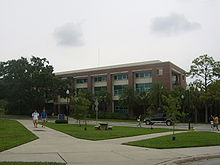
Opened in 2003, Rinker Hall was the first building on campus to receive LEED recognition. Since opening, other new and renovated buildings on campus have also received certification.
In 2005, the University of Florida became a Certified Audubon Cooperative Sanctuary for environmental and wildlife management, resource conservation, enivormental education, waste management, and outreach.
Through long-term enivornmental iniatives, the University of Florida created an Office of Sustainability in 2006. Their mission is to continue to improve environmental sustainability in many different areas on campus. They have stated that their future goals are to produce zero waste by 2015, and to achieve Carbon Neutrality by 2025. Recently the university appointed Anna Prizzia as the University’s new Sustainability Director. UF received a "B+" grade on the 2009 College Sustainability Report Card for its environmental and sustainability initiatives. In 2009 "B+" was the second highest grade awarded by the Sustainable Endowments Institute.
Colleges and academic divisions
The University of Florida is divided into 16 colleges and more than 100 research, service and education centers, bureaus and institutes, offering over 100 undergraduate majors and 200 graduate degrees.
These colleges include:
| College/school founding |
| College/school |
Year founded |
|
| College of Agricultural and Life Sciences |
1906 |
| Rinker School of Building Construction |
1906 |
| College of Education |
1906 |
| Levin College of Law |
1909 |
| College of Engineering |
1910 |
| College of Liberal Arts and Sciences |
1910 |
| College of Journalism and Communications |
1916 |
| College of Pharmacy |
1923 |
| College of Design Construction and Planning |
1925 |
| Warrington College of Business |
1926 |
| P.K. Yonge Research School |
1934 |
| College of Health and Human Performance |
1946 |
| J. Hillis Miller Health Science Center |
1956 |
| College of Medicine |
1956 |
| College of Nursing |
1956 |
| College of Public Health and Health Professions |
1958 |
| Institute of Food and Agricultural Sciences |
1964 |
| College of Dentistry |
1972 |
| College of Fine Arts |
1975 |
| College of Veterinary Medicine |
1976 |
| Division of Continuing Education |
1976 |
| Fisher School of Accounting |
1977 |
| International Center |
1991 |
| Graham Center for Public Service |
2006 |
Satellite facilities
The university also maintains a number of facilities apart from its main campus. The J. Hillis Miller Health Science Center also has a teaching hospital located at Shands Jacksonville that offers degrees in conjunction with the College of Medicine, College of Dentistry, College of Nursing, and College of Pharmacy. A number of residencies are also offered at this facility. The University's College of Pharmacy also maintains campuses in Orlando and St. Petersburg. The College of Dentistry has campuses in South Florida and St. Petersburg.
The university's Warrington College of Business established programs in South Florida back in 2004, and recently built a 6,100 square foot facility in Sunrise, Florida. The Institute of Food and Agricultural Sciences has extensions in each of the 67 counties in Florida, and 13 research and education centers with a total of 19 locations throughout Florida. In 2005, the university established the Beijing Center for International Studies that offers research facilities, offices, and degree opportunities.
Research
See also: Sid Martin Biotechnology Incubator
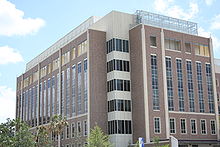
The University of Florida Cancer and Genetics Research Complex is one of several research facilities at the university
The University of Florida is one of the largest research universities in the nation, contributes nearly $6 billion annually to Florida's economy, and is responsible for nearly 75,000 jobs. The Milken Institute named UF one of the top-five U.S. institutions in the transfer of biotechnology research to the marketplace (2006). Some 50 biotechnology companies have resulted from faculty research programs. UF consistently ranks among the top-10 universities in licensing. Royalty and licensing income includes the glaucoma drug Trusopt, the sports drink Gatorade, and the Sentricon termite elimination system. The Institute of Food and Agricultural Sciences, ranked #1 by the NSF in Research and Development, is part of the Flagship University and the current Vice President is Dr. Larry Arrington. It should also be noted that the UF is currently ranked seventh among all private & public universities for the total number of patents awarded for 2005.
The University of Florida was awarded $583 million in total research expenditures, more than all the other Florida universities combined, in sponsored research in 2006-2007. Research includes diverse areas such as health-care and citrus production (the world's largest citrus research center). In 2002, UF began leading six other universities under a $15 million NASA grant to work on a variety of space-related research during a five-year period. UF has a partnership with Spain that helped to create the world's largest single-aperture optical telescope in the Canary Islands (the total cost was $93 million). Plans are also under way for the University of Florida to construct a new 50,000-square-foot (4,600 m) research facility in collaboration with the Burnham Institute for Medical Research that will ultimately be located in the center of UCF's Health Sciences Campus in Orlando, Florida. Research will include the areas of diabetes, aging, genetics and cancer.
| Graduate and Professional Student Enrollment |
| Fall 2008 |
16,214 |
| Fall 2007 |
15,885 |
| Fall 2006 |
15,357 |
| Fall 2005 |
14,594 |
| Fall 2004 |
13,882 |
| Fall 2003 |
13,482 |
| Fall 2002 |
12,902 |
| Fall 2001 |
12,348 |
| Fall 2000 |
11,953 |
| Fall 1999 |
11,216 |
The University of Florida has made great strides in the space sciences over the last decade. The Astronomy Department's focus on the development of image-detection devices has led to increases in funding, telescope time, and significant scholarly achievements. Faculty members in organic chemistry have made notable discoveries in astrobiology, while faculty members in physics have participated actively in the Laser Interferometer Gravitational-Wave Observatory project, the largest and most ambitious project ever funded by the NSF. Through the Department of Mechanical and Aerospace Engineering, the University of Florida is the lead institution on the NASA University Research, Engineering, and Technology Institute (URETI) for Future Space Transport project to develop the next generation space shuttle. In addition, UF is also doing some innovative Diabetes Research In a statewide screening program, that has been sponsored by a $10 million grant from the American Diabetes Association. The University of Florida also houses one of the world's leading lightning research teams. Also UF scientists have started up a biofuels pilot plant that has been specifically designed to test ethanol-producing technology. UF is also host to a nuclear research reactor which is known for its Neutron Activation Analysis Laboratory. In addition, the University of Florida is the first American university to receive a European Union grant to house a Jean Monnet Centre of Excellence.
Health Science Center
Main article: J. Hillis Miller Health Science Center
The J. Hillis Miller Health Science Center (HSC) has facilities in Gainesville and Jacksonville. The HSC comprises the universities's Colleges of Dentistry, Medicine, Nursing, Pharmacy, Public Health & Health Professions and Veterinary Medicine. The Health Science Center is the only academic health center in the United States with six health-related colleges located on a single, contiguous campus. The facility was named after the 4th President of the University of Florida J. Hillis Miller, Sr.. In all the HSC generates over $280 million in total research expenditures for the 2008-2009 fiscal year. The Health Science Center focus on blindness, hypertension and smoking cessation.
The Health Science Center is also affiliated with Shands at the University of Florida, Shands Jacksonville, and the Veterans Affairs hospitals in Gainesville and North Florida/South Georgia. In all 6,159 total students are enrolled in all six of the colleges. Currently being constructed is a new University of Florida Cancer Hospital which can be found on Archer road in Gainesville. The facility is estimated to cost $388 million, and is expected to be 500,000 square feet. The McKnight Brain Institute is also part of the Health Science Center and is the most comprehensive program of its kind in the world. The Institute comprises 300 faculty members from 10 colleges, and 51 departments campus-wide.
The University of Florida is a winner of the National Institutes of Health Clinical and Translational Science Award and member of the prestigious NIH national consortium of medical research institutions.
Partnership with Moffitt Center
In January 2008 the University of Florida, H. Lee Moffitt Cancer Center & Research Institute, and Shands at the University of Florida formed a partnership to develop world-class programs in cancer care, research and prevention. The partnership, will extend Moffitt's innovative model of comprehensive patient care to UF and Shands cancer programs.
Participation in the Large Hadron Collider
A team of UF physicists has a leading role in one of the two major experiments planned for the Large Hadron Collider, a 17-mile-long, $5 billion, super-cooled underground tunnel outside Geneva, Switzerland. More than 30 UF physicists, postdoctoral associates, graduate students and now undergraduates are involved in the collider's Compact Muon Solenoid (CMS) experiment, one of its two major experiments. About 10 are stationed in Geneva. The group is the largest from any university in the U.S. to participate in the CMS experiment. The UF team designed and oversaw development of a major detector within the CMS. The detector, the Muon system, is intended to capture subatomic particles called muons, which are heavier cousins of electrons. Among other efforts, UF scientists analyzed about 100 of the 400 detector chambers placed within the Muon system to be sure they were functioning properly. The bulk of the UF research was funded by the U.S. Department of Energy.
Partnership with Zhejiang University
In July 2008, the University of Florida teamed up with the Zhejiang University to research sustainable solutions to the Earth's energy issues. Overall a Joint Research Center of Clean Sustainable Energy among the Florida Institute for Sustainable Energy, at UF, and the State Key Lab of Clean Energy Utilization and the Institute for Thermal Power Engineering, at Zhejiang University will collaborate to work on this pressing issue.
Libraries
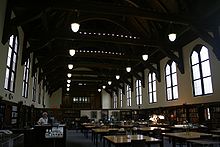
The Smathers Library, first opened in 1926, is the oldest library at the university
Main article: George A. Smathers Libraries
The University of Florida's George A. Smathers Libraries, is one of the largest university library systems in the United States. In total, the University of Florida has ten libraries, and over 5.3 million volumes of books and journals and 7 million microfilms. Collections cover virtually all disciplines and include a wide array of formats – from books and journals to manuscripts, maps, and recorded music. Increasingly collections are digital and are accessible on the Internet via the library web page or the library catalog.
The numerous libraries provide primary support to all academic programs except those served by the Health Science Center Library and the Lawton Chiles Legal Information Center. In 2006, Library West went through a $30 million dollar renovation that doubled capacity. This facility is now better equipped to handle the information technology necessities that students need to complete their studies. Such progress is represented by its state of the art Information Commons [4], which offers production studios, digital media computing areas, and a presentation area.
Academic honesty
HONOR PLEDGE
On my honor, I have neither given nor received unauthorized aid in doing this assignment.
|
|
"In 1995 the University of Florida Student Body revamped the previous Honor Code and voluntarily committed itself to the highest standards of honesty and integrity. When students enroll at the University of Florida, they commit themselves to the standard drafted and enacted by students."
|
校园
Main article: Buildings at the University of Florida
In total the University of Florida campus encompasses over 2,000 acres (8.1 km²). The campus is home to many notable structures, such as Century Tower, a 157 foot tall carillon tower in the center of the historic district. Other notable facilities include the Health Science Center, Ben Hill Griffin Stadium, Reitz Student Union, Smathers Library, Phillips Center for the Performing Arts, Harn Museum, University Auditorium, O'Connell Center, and The Hub.
Historic sites
A number of the University of Florida's buildings are historically significant. The University of Florida Campus Historic District comprises 19 buildings and encompasses approximately 650 acres (2.6 km). Two buildings outside the historic district, the old WRUF radio station (now the university police station) and the old P. K. Yonge Laboratory School (now Norman Hall), are also listed on the historic register. The buildings listed on the U.S. National Register of Historic Places for their architectural or historic significance are:
- Anderson Hall
- Bryan Hall
- Buckman Hall
- Carlton Auditorium
- Dauer Hall
- Century Tower
- Epworth Hall
- Fletcher Hall
- Flint Hall
- Florida Gymnasium
- Floyd Hall
|
|
- Infirmary
- Leigh Hall
- Library East
- Mallory Hall
- Matherly Hall
- Murphree Hall
- Newell Hall
- Old P. K. Yonge Laboratory School
- Old WRUF Radio Station
- Peabody Hall
- Plaza of the Americas
|
|
- Reid Hall
- Rolfs Hall
- Sledd Hall
- The Hub
- Thomas Hall
- Tigert Hall
- University Auditorium
- Walker Hall
- Weil Hall
- Women's Gymnasium
- Yulee Hall
|
Student life
Career development and internships
The Career Resource Center at the Reitz Student Union helps by providing a comprehensive, state-of-the-art facility. The Center provides services for students and alumni to assist them to achieve career development, career experiences, and employment opportunities.
Fraternities & sororities
Approximately 5,200 undergraduate students (or approximately 15%) are members of either a sorority or fraternity. Sorority and Fraternity Affairs (formerly known as Greek Life) at the University of Florida is separated into four divisions: Interfraternity Council (IFC), National Panhellenic Conference (NPC), Multicultural Greek Council (MGC), and the National Pan-Hellenic Council (NPHC). The Order of Omega has a chapter at the university.
The Interfraternity Council (IFC) comprises 25 fraternities, and the Panhellenic Council is made up of 16 sororities. Some of the fraternities on campus are older than the university itself with the first fraternities being founded in 1884.
The Multicultural Greek Council consists of 12 cultural organizations (拉丁语o, Asian, South Asian, etc.), seven fraternities and five sororities. The National Pan-Hellenic Council comprises nine historically-black organizations, five fraternities and four sororities). There are now also two recognized fraternal organizations for Christian students.
| Fraternities |
Sororities |
- Alpha Epsilon Pi
- Alpha Gamma Rho
- Alpha Phi Alpha
- Alpha Tau Omega
- Beta Chi Theta
- Beta Theta Pi
- Beta Upsilon Chi
- Chi Phi
- Delta Chi
- Delta Tau Delta
- Delta Upsilon
- Iota Phi Theta
- Kappa Alpha Order
- Kappa Alpha Psi
|
- Kappa Kappa Psi
- Kappa Sigma
- Kappa Upsilon Chi
- Lambda Alpha Upsilon
- Lambda Chi Alpha
- Lambda Theta Phi
- Omega Delta Phi
- Omega Psi Phi
- Phi Beta Lambda
- Phi Beta Sigma
- Phi Delta Theta
- Phi Gamma Delta
- Phi Kappa Tau
- Phi Sigma Kappa
|
- Pi Delta Psi
- Pi Kappa Alpha
- Pi Kappa Phi
- Pi Lambda Phi
- Sigma Alpha Epsilon
- Sigma Beta Rho
- Sigma Chi
- Sigma Lambda Beta
- Sigma Nu
- Sigma Phi Epsilon
- Sigma Pi
- Tau Kappa Epsilon
- Theta Chi
- Zeta Beta Tau
|
- Alpha Kappa Alpha
- alpha Kappa Delta Phi
- Alpha Chi Omega
- Alpha Delta Pi
- Alpha Epsilon Phi
- Alpha Omicron Pi
- Chi Omega
- Delta Delta Delta
- Delta Gamma
- Delta Phi Epsilon
- Delta Phi Omega
- Delta Sigma Theta
- Delta Zeta
- Gamma Eta
- Kappa Alpha Theta
|
- Kappa Delta
- Kappa Kappa Gamma
- Kappa Phi Lambda
- Lambda Theta Alpha
- Phi Mu
- Pi Beta Phi
- Sigma Gamma Rho
- Sigma Kappa
- Sigma Lambda Gamma
- Sigma Phi Lambda
- Tau Beta Sigma
- Theta Nu Xi
- Zeta Phi Beta
- Zeta Tau Alpha
|
Reserve Officer Training Corps
Main article: University of Florida ROTC
The University of Florida Reserve Officer Training Corps is the official officer training and commissioning program at the University of Florida. Officially founded in 1905, it is one of the oldest such programs in the nation.
The Reserve Officer Training Corps offers commissions for the United States Army, United States Navy, United States Marine Corps, and the United States Air Force. The unit is one of the oldest in the nation, and is currently located at Van Fleet Hall.
The Reserve Officer Training Corps at the University of Florida offers training in the military sciences to students who desire to perform military service after they graduate. The Departments of the Army, Air Force, and Navy each maintain a Reserve Officers Training Corps and each individual department has a full staff of military personnel.
Housing
Main article: University of Florida student housing
The University of Florida provides over 9,200 students with housing in residence halls and complexes on the eastern and western sides of campus. Facilities vary in the cost of rent and privacy. Housing plans also offer students access to dining facilities. The university also provides housing to a number of graduate students and their families.
Recreation
Many recreational activities available for students include indoor and outdoor sports, outdoor courts and playing fields on campus, in the Stephen C. O'Connell Center, University Golf Course, Plaza of the Americas, the Student Recreation and Fitness Center, the Southwest Recreation Center, and the Florida Gymnasium for indoor sports. Florida offers intramural and club sports ranging from archery to weightlifting. Near the campus are many recreational lakes and rivers, including university-owned Lake Alice. In addition, student have access to the J. Wayne Reitz Union which is equipped with a bowling alley, pool tables, an arcade, and numerous other activities. South of Gainesville is Lake Wauburg, which also provides recreational activities for students, faculty, and staff. To the northwest of campus is the Devil's Millhopper Geological State Park.
The campus also contains open spaces, small ponds, picnic areas, shady nooks and an 81-acre wildlife sanctuary that provide opportunities to enjoy Florida's year-round sunshine activity life.
Lastly, the University of Florida has more than eight hundred organizations and clubs for students to join. They range from cultural and athletic to subjects pertaining to philanthropy. Some of the most popular organizations are Florida Blue Key, Theatre Strike Force, the Marching Band, Florida Competitive Cheerleading, Dazzlers, the Gatorettes, Hillel at UF, Gator Growl, Progressive Black Journalists, Miss University of Florida, and the Speakers Bureau. If students wish they can create their own registered student organization if the current interest or concern is not addressed by the previously established entities.
Student affairs rankings
The University of Florida received the following rankings by "The Princeton Review" in its "2010 Best 368 Colleges Rankings:"
| Category |
Rankings |
| Best Career/Job Placement Services |
1st overall |
| Jock School |
2nd overall |
| Students Pack the Stadium |
2nd overall |
| Party School |
2nd overall |
| Lots of Beer |
4th overall |
| Best College Newspaper |
8th overall |
| Major Frat and Sorority Scene |
12th overall |
| Everyone Plays Intramural Sports |
15th overall |
Student government
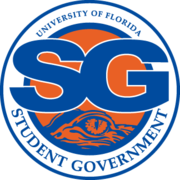
Seal for the UF Student Government
The University of Florida Student Government is the governing body of students who attend the University of Florida, representing the university's more than 49,000 undergraduate, graduate and professional students. The university's student government currently operates on a yearly $13.8 million dollar budget, one of the largest student government budgets in the United States.
The student government was established in 1909 and consists of executive, judicial and unicameral legislative branches. The executive branch includes the student government president, vice president and treasurer elected by the student body during the spring semester, as well as nine agencies and forty-one cabinet members.
The student senate is the legislative branch, and is composed of 100 senators who serve one-year terms. The student body elects fifty senators during each spring semester and the remaining fifty during the fall semester. The senators elect a senate president and senate President pro tempore twice a year, after each semester's elections, to lead the student senate. During student government elections students may also vote on referendums, such as the renewable energy referendum, which was approved by 78% of voting students in the spring of 2007. This referendum proposed a fifty-cents-per-credit-hour increase to student activity fees to fund renewable energy and efficiency on campus.
The student government judicial branch has three major components: the student supreme court (headed by a chief justice), the student honor court (headed by the honor court chancellor elected each spring), and the student traffic court (headed by a chief justice). The supreme court consists of five second or third-year law students nominated by the student government president and confirmed by the student senate. Each justice serves a "life-time" term, which extends through the individual justice's graduation and insulates the court from the politics of student government. The chief justice may appoint a marshal and clerk. The election commission, which listens and adjudicates all student government election complaints, is also part of the judicial branch. The commission includes 6 members, one of whom also serves as the commission chairman.
Alma Mater
The Alma Mater for the University of Florida was composed by Milton Yeats in 1925.
Campus & area transportation
The UF campus is served by nine bus routes of the Gainesville Regional Transit System (RTS). Students, faculty, and staff with university-issued ID cards are able to use the system at no extra cost. The RTS also provides other campus services, including Gator Aider (during football games) and Later Gator nighttime service..
University of Florida is also served by the Gainesville Regional Airport, which is located in the Northeast portion of Gainesville and has daily services to Atlanta and Charlotte.
Student media
The University of Florida supports six major student-run media outlets.
- The Independent Florida Alligator is the largest student-run newspaper in the U.S. and operates without oversight from the university administration.
- WLUF-LP is a low-power television station that carries a mix of educational and PBS programming.
- WRUF (850 AM) features a mixture of local and syndicated talk programs, award-winning student-produced newscasts and sports talk shows, plus religious programming on Sunday mornings.
- WRUF-FM (103.7 FM) broadcasts Rock music and attracts an audience from the Gainesville and Ocala areas.
- WUFT is a PBS member station with a variety of programming that includes a daily student-produced newscast.
- WUFT-FM (89.1 FM) is an NPR member radio station which airs news and public affairs programming, including student-produced long-form news reporting. WUFT-FM's programming also airs on WJUF-FM (90.1).
Various other journals and magazines are published by the university's academic units and student groups, including the literary journal Subtropics.
Museums
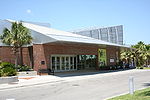
Museum of Natural History
The Florida Museum of Natural History, established in 1891, is one of the oldest natural history museums in the country and was officially chartered by the State of Florida. This facility is dedicated to understanding, preserving and interpreting biological diversity and cultural heritage. In over 100 years of operations the Florida Museum of Natural History has been housed in several buildings, from the Seagle Building to facilities at Dickinson Hall, Powell Hall, and the Randell Research Center. In 2000 the McGuire Center for Lepidoptera and Biodiversity was opened after a generous donation from University of Florida benefactors. The McGuire Center houses a collection of more than six million butterfly and moth specimens, making it one of the largest collections of Lepidoptera in the world, rivaling that of the Natural History Museum in London, England.
The Samuel P. Harn Museum of Art, established in 1990, is also located at the University of Florida on the southwest part of campus. This facility is one of the largest university art museums in the Southeast, the Harn has more than 7,000 works in its permanent collection and an array of temporary exhibitions. The museum's permanent collections are focused on Asian, African, modern and contemporary art, as well as photography. The university sponsors educational programs at the museum including films, lectures, interactive activities, and school and family offerings. In October 2005 the Harn expanded by more than 18,000 square feet with the opening of the Mary Ann Harn Cofrin Pavilion, which includes new educational and meeting areas and the Camellia Court Cafe, the first eatery for visitors of the Cultural Plaza.
Performing arts and music
Performing arts venues at the University of Florida consist of the Curtis M. Phillips Center for the Performing Arts, the University Auditorium, Constans Theatre, the Baughman Center, and performances at the Stephen C. O'Connell Center. The mission is to provide an unparalleled experience where the performing artists create and share knowledge to serve the student body, faculty, and staff at the university; Gainesville residents; and visitors to North Central Florida.
The University Auditorium was founded in the mid 1920's and is home to the Anderson Memorial Organ. The auditorium has a concert stage and can seat up to 843 patrons. The venue is suitable for musical concerts, special lectures, convocations, dance concerts, and pageants.
The Phillips Center for the Performing Arts was founded in 1992 and is a performing arts theatre. The Phillips Center is located on the western side of campus, and hosts established and emerging national and international artists on the main stage, as well as the annual Miss University of Florida pageant. In all, the Phillips Center consists of a 1,700-seat proscenium hall and the 200-seat Squitieri Studio Theatre.
Constans Theatre was founded in 1967 and is a performing arts venue located next to the J. Wayne Reitz Union. Constans Theatre serves as a venue for musical concerts, theater, dance, and lectures, and is a sub-venue of the Nadine McGuire Pavilion and Dance Pavilion.
The Baughman Center was founded in 2000 and serves as a venue for small musical and performing arts events. The facility consists of two buildings located next to Lake Alice on the western portion of campus. The main building is a 1,500-square-foot pavilion, while the other is a 1,000-square-foot administrative building. Overall the Baughman Center can accommodate up to 96 patrons.
In popular culture
Main article: University of Florida in popular culture
The University of Florida has been portrayed in several films, books, and television shows. In addition, the University of Florida campus has been the backdrop for a number of different movies, books, and even a song by Tom Petty and the Heartbreakers.
The University of Florida has been portrayed in a variety of television shows and motion pictures. Fictional UF alumni and faculty include Kevin Lomax and Mary Ann Lomax who were characters in the film The Devil's Advocate. In the film Days of Thunder, the character Harry Hogge can be seen wearing a University of Florida ballcap. Marjorie Kinnan Rawlings is the main character in the film Cross Creek. In the film Deuce Bigalow: European Gigolo a side character named Earl McManus is shown wearing a Florida Gators hat. The politician Robert Ritchie from the show The West Wing was a graduate of the university. Jim Morrison in the film The Doors was incorrectly portrayed as former University of Florida student. In a number of Adam Sandler's films he can often be seen wearing Florida's orange and blue sweatshirts and t-shirts. In the film The Hawk is Dying is based on the professor Harry Crews who served as a faculty member for the university. In the television show Miami Vice the protagonist James "Sonny" Crockett had played for the football team.
Robert Cade, a professor at the university's College of Medicine, invented the ubiquitous sports drink Gatorade as a hydration supplement for the Florida Gators football team in 1965–1966. A series of recent Gatorade television commercials, "The Legend of Gatorade," have prominently featured the university and the Gators.
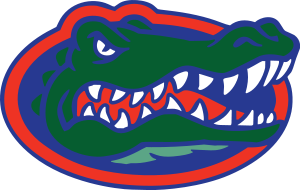
Logo of the Florida Gators, a trademark of the University Athletic Association, Inc., the non-profit corporation responsible for managing the intercollegiate sports program of the University of Florida.
Sports
Main article: Florida Gators
See also: University of Florida Athletic Association
The University of Florida's intercollegiate sports teams, known as the "Florida Gators," compete in National Collegiate Athletic Association (NCAA) Division I and the Southeastern Conference (SEC). For the 2009–2010 school year, the University Athletic Association has budgeted more $85 million for its sports teams and facilities. Since 1986, the Gators have won nineteen of the last twenty-three SEC All-Sports Trophies, recognizing Florida as the best overall athletics program in the SEC. Florida's athletic program has ranked among the top five in the nation in twelve of the past seventeen years, and it is the only Division I program that has ranked among the top ten athletic programs in the country in each of the last twenty-three years.
Florida has won a total of twenty-four team national championships, nineteen of which are NCAA championships. Florida is one of only two Division I FBS universities to win multiple national championships in each of the two most popular NCAA sports: football (1996, 2006, 2008) and men's basketball (2006, 2007).
Olympics
Main article: List of University of Florida Olympians
The University of Florida has a long history of producing athletes who compete in the Olympic Games. Over 150 Gator athletes from over thirty different countries have competed in the Games, winning forty-four Olympic gold medals, twenty-three silver medals and twenty-three bronze medals through the 2008 Summer Olympics. The list of notable Gator Olympians and gold medalists includes sprinters Kerron Clement, Dennis Mitchell and Bernard Williams; marathon runner Frank Shorter; baseball outfielder Brad Wilkerson; basketball forward DeLisha Milton-Jones; soccer forward Abby Wambach; and swimmers Ryan Lochte, Tracy Caulkins, Nicole Haislett and Dara Torres.
Football
Main article: Florida Gators football
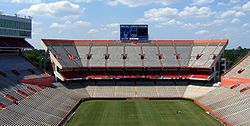
Interior of Ben Hill Griffin Stadium, also known as "The Swamp."
The University of Florida fielded its first official varsity football team in the fall of 1906, when the university held its first classes on its new Gainesville campus. Since then, the Florida Gators football team has played in thirty-seven bowl games, won three consensus national championships and eight Southeastern Conference (SEC) championships, produced 135 All-Americans, thirty-five National Football League (NFL) first-round draft choices, and three Heisman Trophy winners.
The Gators won their first post-season game on Christmas Day 1912 in the Bacardi Bowl, beating the Vedado Athletic Club 28–0 in Havana, Cuba. The Gators earned national attention in 1928, setting a national record for most points scored in a season by an 8–1 team that also produced the Gators' first All-American, end Dale Van Sickel. The Gators' first major bowl win was the 1967 Orange Bowl in which coach Ray Graves and Heisman Trophy quarterback Steve Spurrier led the Gators to a 27–12 victory over the Georgia Tech Yellow Jackets.
In 1990, Spurrier returned his alma mater as its new head coach, and spurred the Gators to their first six official SEC football championships (1991, 1993, 1994, 1995, 1996, 2000). The Gators, quarterbacked by their second Heisman Trophy winner, Danny Wuerffel, won their first national championship in 1996 with a 52–20 winover Florida State Seminoles in the Sugar Bowl. The current head football coach, Urban Meyer, led the Gators in celebrating the 100th anniversary of Florida football in 2006, when the Gators finished the season 13–1, captured their seventh SEC Championship, and defeated the top-ranked Ohio State Buckeyes 41–14 for the BCS National Championship. At the conclusion of the 2008 season, the Gators' third Heisman-winning quarterback, Tim Tebow, led them in a 24–14 BCS Championship Game victory over the Oklahoma Sooners for their third national championship.
Since 1930, the Gators' home field has been Ben Hill Griffin Stadium, which seats over 90,000 fans—the twelfth largest college football venue in the country. The stadium is popularly known as "The Swamp", and The Sporting News has named Florida's fans as the top college crowd in the nation and ranked the stadium as the nation's loudest.
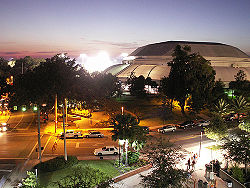
The Stephen C. O'Connell Center is the home arena of the Florida Gators men's basketball team.
Basketball
Main article: Florida Gators men's basketball
The Florida Gators men's basketball team has also gained national recognition in the past twenty years. The Gators went to the Final Four of the 1994 NCAA tournament under coach Lon Kruger, and coach Billy Donovan led the Gators back to the NCAA Final Four in 2000, where they lost to the Michigan State Spartans in the final. Under Donovan, the Gators won their first Southeastern Conference (SEC) tournament championship in 2005, beating the Kentucky Wildcats. After repeating as SEC tournament champs in 2006, the Gators won their first basketball national championship, defeating the UCLA Bruins 73–57 in the final game of the NCAA basketball tournament.
In 2007, the Gators beat the Arkansas Razorbacks 77–56 to win their third consecutive SEC tournament title. Florida defeated Ohio State 84–75 to again win the NCAA basketball tournament championship, and became the first team in NCAA history to win back-to-back national championships with the same starting line-up.
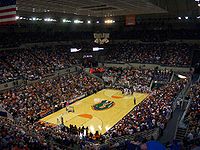
Interior view of the Stephen C. O'Connell Center, configured for basketball.
The Gators play their home games in the Stephen C. O'Connell Center. The 12,000-seat multi-purpose indoor arena was completed in 1980, and is popularly known as the "O'Dome." The student basketball fan section of the O'Dome is known as the "Rowdy Reptiles."
Notable alumni
Main article: List of University of Florida alumni
See also: University of Florida Alumni Association
The University of Florida has more than 340,000 living alumni. Florida alumni account for multiple Nobel Prize winners, nine U.S. Senators, almost 40 U.S. Representatives, 11 state governors, and eight U.S. ambassadors, multiple state supreme court judges, and various federal courts judges. UF graduates have served as the executive leaders of such diverse institutions as the United States Marine Corps and the National Organization for Women.
Florida alumni have been the presidents of Florida State University, the College of Charleston, New College of Florida, Randolph-Macon College, Rice University, Rutgers University, the University of Central Florida, the University of South Florida and Miami University. Major business enterprises run by Florida graduates include Amtrak, Avaya, Boeing Enterprises, the Boston Red Sox, Burger King, Deloitte & Touche, Discover Financial, FedEx, Gartner, Gate Petroleum, Golin Harris International, the Houston Astros, Hudson's Bay Company, J. C. Penney, Macy's, Merrill Lynch, [MTV]], NASCAR, Nike, Northwest Airlines, Reebok, The Richards Group, Scripps, Scripps, the Tampa Bay Buccaneers and Walt Disney. University of Florida alumni have also led such professional and governmental regulatory bodies such as American Bar Association, The Florida Bar, the Environmental Protection Agency, the Federal Communications Commission, the Federal Trade Commission, the Nuclear Regulatory Commission, and the United States Department of Transportation. In addition, has a history of twelve Rhodes Scholars and 1 Marshall Scholar.
Among the people who have attended or graduated from the University of Florida are actress Faye Dunaway, Price is Right announcer Rich Fields, author Michael Connelly, Nobel Prize winners Marshall Nirenberg and Robert Grubbs, pilot Paul Tibbets, governor & senator Bob Graham, reporter Stephanie Abrams, musician Mel Tillis, award winning architect Lawrence Scarpa, poet Geri Doran, director Jonathan Demme, comedian Darrell Hammond, columnist Kiki Carter, congressman Adam Putnam, actor Stephen Root, sportscaster Red Barber, sportscaster Jesse Palmer, producer Scott Sanders, U.S. Senator and Florida governor Lawton Chiles, TV personality Bob Vila, novelists Kate DiCamillo and Carl Hiaasen, judges William Dimitrouleas and Harold Sebring, administrators Carol Browner and Alan Stephenson Boyd, inventor John Atanasoff, U.S. Senator Bill Nelson, owner of Yankees franchise Hal Steinbrenner, guitarist & songwriter Stephen Stills, and the daughter of Dave Thomas, Wendy Thomas, the namesake of the food-chain Wendy's also attended the University of Florida.
The University of Florida has also been home to over 125 Olympians throughout the years, nearly 150 active and retired NFL football players and three Heisman Trophy winners, more than thirty MLB baseball players, thirty NBA basketball players, and over forty PGA Tour and LPGA golfers. Famous University of Florida athletes include the NFL all-time leading rusher Emmitt Smith, NFL Hall of Fame football player Jack Youngblood, tennis players Lisa Raymond and Jesse Levine, golfer Tommy Aaron, basketball center Joakim Noah, baseball player David Eckstein, soccer players Abby Wambach and Heather Mitts, swimmers Tracy Caulkins, Nicole Haislett, Ryan Lochte and Dara Torres, and football coach Steve Spurrier.
Notable faculty
Main article: List of University of Florida faculty and administrators
Individual awards won by UF faculty include a Fields Medal, numerous Pulitzer Prizes, and NASA's top award for research and Smithsonian Institution's conservation award. There are currently more than 60 Eminent Scholar chairs, and nearly 60 faculty elections to the National Academy of Sciences, Engineering, or Arts and Sciences, the Institute of Medicine or a counterpart in a foreign nation. More than two dozen faculty are members of the National Academies of Science and Engineering and the Institute of Medicine or counterpart in a foreign nation.
University benefactors
See also: University of Florida Investment Corporation
The University of Florida has had many financial supporters, but some stand out by the magnitude of their contributions.
Among those who have made large donations commemorated at the university are:
- David A. Cofrin
- Jerry & Judy Davis
- Frederick E. Fisher
- William R. Hough
- Fred G. Levin
|
|
- Bill & Nadine McGuire
- Evelyn & William McKnight
- John C. Pruitt
- Jim & Alexis Pugh
- Davis & Judi Rembert
|
|
- Marshall E. Rinker
- George A. Smathers
- Alfred C. Warrington
- Cornelius Vanderbilt Whitney
|
Photo gallery
University of Florida Cancer Hospital
|
|
|
University of Florida Hillel
|
|
|
|
|
|
|
|
|
|
|
|
|
|
更多
- ACCENT Speakers Bureau
- Askew Institute on Politics and Society
- Buildings at the University of Florida
- Century Tower
- Constans Theatre
- Florida Blue Key
- Florida Gators
- Gatorade
- Gator Growl
- History of the University of Florida
- The Independent Florida Alligator
- Lake Alice
- List of Presidents of the University of Florida
- List of University of Florida faculty
- List of University of Florida honorary degree recipients
- Ligature Design Symposium
- Lombardi Scholars Program
- MacroCenter
- President's House
- Reitz Scholars Program
- Subtropics Literary Magazine
- University of Florida Alumni Association
- University Athletic Association
- University of Florida Cancer Hospital
- Career Resource Center at UF
- University of Florida Press
参考文献
- ^ As of June 30, 2009. "U.S. and Canadian Institutions Listed by Fiscal Year 2009 Endowment Market Value and Percentage Change in Endowment Market Value from FY 2008 to FY 2009" (PDF). 2009 NACUBO-Commonfund Study of Endowments. National Association of College and University Business Officers. http://www.nacubo.org/Documents/research/2009_NCSE_Public_Tables_Endowment_Market_Values.pdf. Retrieved March 16, 2010.
- ^ www.ir.ufl.edu/factbook/staff.htm
- ^ Zaragoza, Luis (October 14, 2009). "UCF now largest university in Florida". Orlando Sentinel. http://www.orlandosentinel.com/news/education/orl-ucf-number-one-101409,0,126628.story. Retrieved October 14, 2009.
- ^ Julian M. Pleasants, Gator Tales: An Oral History of the University of Florida, University of Florida, Gainesville, Florida, pp. 6–7 (2006). The university's 1853 "founding date" represents the year that the East Florida Seminary opened in Ocala. The seminary was the oldest of the four colleges that were consolidated by the Florida Legislature to form the modern University of Florida in 1905.
- ^ University of Florida, University of Florida History 1853–1905. Retrieved August 26, 2009.
- ^ Howard R. Greene & Matthew W. Greene, The Public Ivies: America's Flagship Public Universities, Cliff Street Books, New York, New York (1st ed. 2001). ISBN 0-06-093459-X
- ^ U.S. News & World Report, Best Colleges 2010, 2010 National University Rankings. Retrieved August 20, 2009.
- ^ "About UF." University of Florida.
- ^ Florida Senate, Florida Senate Bill 1710. Retrieved August 26, 2009. The other two research flagship universities are Florida State University and the University of South Florida.
- ^ "The history of Gatorade." Gatorade.
- ^ Nathan Crabbe, "UF is no longer largest in state as classes start; Official says UF emphasis is on quality, not quantity," Gainesville Sun (August 25, 2009). Retrieved August 26, 2009.
- ^ See, e.g., "Academic Ranking of World Universities 2008: Top 500 World Universities," Institute of Higher Education, Shanghai Jiao Tong University; "Ranking of Top World Research Universities," Research Center for Chinese Science Evaluation, Wuhan University; and "2009 Ranking Web of World Universities: North America," Webometrics. Retrieved July 12, 2009. See also U.S. News & World Report, Best Colleges 2010, 2010 National University Rankings. Retrieved August 20, 2009.
- ^ Office of Institutional Planning and Research - UF Factbook," University of Florida. Retrieved October 30, 2009.
- ^ "Merit cuts have not hurt UF's draw," Gainesville Sun (January 18, 2008).
- ^ Source for UF's Operating Budget)
- ^ University of Florida, Graduate School
- ^ Gatorzone.com, University Athletic Association, National Championship Overview. Retrieved August 15, 2009.
- ^ Governor Thomas Brown signs Higher Education bill
- ^ "Kingsbury Papers", Smathers Library.
- ^ "UF Early History", University of Florida.
- ^ The present university campus incorporates much of the former seminary and academy campuses. Epworth Hall, one of the the main building of the East Florida Seminary, still stands in downtown Gainesville, but is not within the boundaries of the university's campus.
- ^ University of Florida, UF Timeline. The name, the "University of Florida," has been held by three separate schools: the West Florida Seminary was renamed the "University of Florida" by the legislature, and held the name from 1883 to 1902; Florida Agricultural College was renamed in 1902 and held the name until 1905; and the name of the new University of the State of Florida was simplified to the University of Florida in 1909. Oddly, the West Florida Seminary was the major predecessor to the modern Florida State University in Tallahassee.
- ^ "Buckman Hall Quick Facts." Department of Housing, University of Florida.
- ^ About the Buckman Act consolidation
- ^ "State Library and Archives of Florida - The Florida Memory Project Timeline (see 1905)". http://www.floridamemory.com/Timeline. Retrieved 2008-06-05.
- ^ "University of Florida History 1906-1927." University of Florida. August 9, 2006.
- ^ University of Florida: College of Liberal Arts and Sciences-Notable Women at UF
- ^ University of Florida website: History-1925 » First Woman Enrolls
- ^ "The NCAA News"
- ^ "Florida State History", Florida State University.
- ^ About the post-war expansion
- ^ UF looking to transform itself
- ^ 2009 Kiplinger Ranking
- ^ "Public Universities Chase Excellence, at Price." New York Times.
- ^ Tuition costs
- ^ Law School tuition costs
- ^ Medical School tuition costs
- ^ "Undergraduates Students, by Ethnicity" (Student breakdown). Petersons.com. 2009. http://www.petersons.com/collegeprofiles/Profile.aspx?inunid=9188&reprjid=12&sponsor=1&tabid=10005. Retrieved 2009-07-19.
- ^ "B02001. RACE - Universe: TOTAL POPULATION". 2006 American Community Survey. United States Census Bureau. http://factfinder.census.gov/servlet/DTTable?_bm=y&-context=dt&-ds_name=ACS_2006_EST_G00_&-CONTEXT=dt&-mt_name=ACS_2006_EST_G2000_B02001&-tree_id=306&-redoLog=false&-currentselections=ACS_2006_EST_G2000_B02001&-currentselections=ACS_2006_EST_G2000_B02003&-currentselections=ACS_2006_EST_G2000_C02003&-geo_id=01000US&-geo_id=02000US1&-geo_id=02000US2&-geo_id=02000US3&-geo_id=02000US4&-search_results=01000US&-format=&-_lang=en. Retrieved 2002-02-09.
- ^ Petersons.com demographic breakdown
- ^ http://www.gainesville.com/article/20090104/NEWS/901041006/1002?p=3&tc=pg
- ^ Chronicle of Higher Education international student population
- ^ Petersons.com Internation Student statistics
- ^ Rank for African American and Hispanic students
- ^ Graduate enrollment for African American and Hispanic students
- ^ About the graduate program offered at the university
- ^ UF Factbook info about degrees offered
- ^ Shanghai Jiao Tong University (2009). "Academic Ranking of World Universities". Institute of Higher Education, Shanghai Jiao Tong University. http://www.arwu.org/ARWU2009.jsp. Retrieved 2009-12-23.
- ^ Shanghai Jiao Tong University (2009). "Ranking of North & Latin American Universities". Institute of Higher Education, Shanghai Jiao Tong University. http://www.arwu.org/Americas2009.jsp. Retrieved 2009-12-23.
- ^ "National Universities Rankings". America's Best Colleges 2009. U.S. News & World Report. 2009. http://colleges.usnews.rankingsandreviews.com/college/national-search. Retrieved 2009-05-18.
- ^ "The Washington Monthly National University Rankings" (PDF). The Washington Monthly. 2009. http://www.washingtonmonthly.com/college_guide/rankings/national_university_rank.php. Retrieved 2009-12-23.
- ^ U.S. News & World Report, 2010 Public University Rankings Retrieved August 20, 2009.
- ^ U.S. News & World Report, 2010 National University Rankings Retrieved August 20, 2009.
- ^ U.S. News & World Report, Top 10 Most Popular National Universities Retrieved July 6, 2009.
- ^ "Academic Ranking of World Universities." Institute of Higher Education, Shanghai Jiao Tong University. 2007.
- ^ "The Washington Monthly College Rankings" (PDF). http://www.washingtonmonthly.com/features/2007/0709.natlrankings.pdf. Retrieved 2008-03-11.
- ^ "Top 25 Hottest Schools"
- ^ "World Webometrics rankings"
- ^ World ranking by Wuhan University
- ^ Kiplingers: 100 Best Values in US Public Colleges
- ^ "New study: UF contributes nearly $6 billion to Florida economy". Press release. 2007-05-14. http://news.ufl.edu/2007/05/14/uf-econ-impact/. Retrieved 2007-09-16.
- ^ http://www.princetonreview.com/schoollist.aspx?id=685&type=r&uidbadge=%07
- ^ Strauss, Valerie (26 April 2010). "Column:The Answer Sheet". Washington, DC: Washington Post. pp. B2. http://voices.washingtonpost.com/answer-sheet/sports/with-the-national-football-lea.html.
- ^ "UF Admit rate 2008". Official site. 2008-03-01. http://www.gainesvillesun.com/article/20080219/NEWS/802190315/1002/NEWS. Retrieved 2008-03-01.
- ^ "UF Freshman profile 2007 - 2005". 2008-03-01. http://www.admissions.ufl.edu/ugrad/frprofile.html. Retrieved 2008-03-01.
- ^ "One UF; 27,850 freshman wannabes". 2009-02-13. http://www.heraldtribune.com/article/20090213/ARTICLE/902130362/0/SPORTS. Retrieved 2009-06-02.
- ^ AAU retention rate
- ^ 2008 University of Florida Admissions
- ^ Scott, Anna (2007-07-22), "More find their University of Florida dreams dashed", Herald Tribune, http://www.heraldtribune.com/article/20070722/NEWS/707220481, retrieved 2008-09-09
- ^ The Independent Florida Alligator: News - 28,000 UF hopefuls await final decision
- ^ Gainesville Sun info about UF ending Early Decision
- ^ Farrell, Elizabeth (2007-04-03), "UF's abolishes Early Decision Admissions", Chronicle of Higher Education, http://chronicle.com/news/article/1926/u-of-florida-abandons-early-decision-admissions, retrieved 2007-09-16
- ^ Honors Program)
- ^ About the courses offered by the Honors Program
- ^ Honors Program opportunities
- ^ Admission requirements
- ^ Audubon Cooperative info
- ^ About Office of Sustainability at UF
- ^ Future goals of Sustainability
- ^ http://www.greenreportcard.org/report-card-2009/schools/university-of-florida-gainesville
- ^ About the Colleges at the University of Florida
- ^ About the graduate/professional programs
- ^ "University of Florida Colleges". University of Florida. December 26, 2008. http://www.ufl.edu/colleges/. Retrieved 2008-12-26.
- ^ Programs offered at Shands Jacksonville
- ^ Warrington builds facility in Sunrise, Florida
- ^ IFAS locations
- ^ About the Beijing Center
- ^ Milken Institute rankings
- ^ 2007 Gator Football Media Guide, pp.18-20
- ^ "NSF Ag Top 5"
- ^ "UF receives record $583 million in research funding". Press release. 2007-08-23. http://news.ufl.edu/2007/08/23/research2007/. Retrieved 2007-09-16.
- ^ About UF and NASA partnership
- ^ About the UF and Burnam Institute partnershp
- ^ Graduate/Professional enrollment
- ^ UF and the NSF
- ^ About LIGO
- ^ UF and URETI
- ^ About the ADA grant
- ^ About the Training Reactor
- ^ The Independent Alligator article
- ^ About the Health Science Center
- ^ 2008-2009 research funding
- ^ Facts about the Health Science Center
- ^ Cancer Hospital
- ^ UF, Moffitt, and Shands partnership
- ^ UF involvement with the Large Hadron Collider
- ^ UF physicists to take part in world’s most ambitious science experiment
- ^ InsideUF - UF, China’s Zhejiang University to collaborate on clean energy research
- ^ UF, China's Zhejiang University To Collaborate On Clean Energy Research
- ^ About the Libraries at UF
- ^ Petersons.com library collection statistics
- ^ About the Library West renovation
- ^ University of Florida, Library West Dedication, Part 2 - AOL Video
- ^ Office of the University Registrar
- ^ UF Campus Map
- ^ "Florida's History Through Its Places: Alachua County". Florida Department of State. http://dhr.dos.state.fl.us/facts/reports/places/Counties/Alachua.cfm. Retrieved 2008-09-09.
- ^ [1] Official UF Historic Site Guide.
- ^ Career Resources Center at UF
- ^ UF Greek Life statistics
- ^ Oldest fraternities at UF
- ^ "Christian Fraternity Rush" Independent Florida Alligator.
- ^ Air Force Page
- ^ Army Page
- ^ Navy Page
- ^ Student catalog info about the ROTC Program
- ^ About Housing for students
- ^ Graduate/Professional housing at UF
- ^ University of Florida Athletics
- ^ Petersons.com info about student organizations
- ^ Center for Student Involvement
- ^ Priceton Review rankings for 2010
- ^ [2] Student Government Budget
- ^ [3] June 5, 2009
- ^ UF Traditions - Gamedays : Songs & Cheers - Alma Mater
- ^ About the Later Gator
- ^ About the Gainesville Airport
- ^ Historical background
- ^ About the Museum of Natural History
- ^ About the McGuire Center
- ^ McGuire Center info
- ^ About the Harn Museum
- ^ Info about the Harn Collection
- ^ Harn Museum Info
- ^ About the performing arts at UF
- ^ About the Performing Arts at the university
- ^ About the University Auditorium
- ^ About the Phillips Center
- ^ About Constans Theatre
- ^ About the Baughman Center
- ^ In football, Florida competes in the NCAA Football Bowl Subdivision (FBS), still often referred to by its former designation of "Division I-A."
- ^ Gainesville Sun talks about UF's athletic success
- ^ Florida Gators in the NACDA
- ^ "University Athletic Association". University of Florida Athletic Association, Inc.. http://www.gatorzone.com/overview/. Retrieved 2008-02-28.
- ^ "Schools with the Most NCAA Championships". NCAA. http://www.ncaa.org/champadmin/champs_listing1.html. Retrieved 2008-02-28.
- ^ Former Gator athletes had won thirty-nine Olympic gold, nineteen silver, and eighteen bronze medals through the conclusion of the 2004 Summer Olympic in Athens, Greece. See Gatorzone.com, Gators in the Olympics. Retrieved July 28, 2009. During the 2008 Summer Olympic in Beijing, China, Gators won another five gold, four silver and five bronze medals. Gatorzone.com, Gators in the Olympics, Gators in the Olympics - August 23 (corrected). Retrieved July 28, 2009.
- ^ Gatorzone.com, Gator Football All-Americans.
- ^ The university's athletic department, the University Athletic Association (UAA), considers the Bacardi Bowl to be a "post-season exhibition game" only, and not an "official" bowl game. See Gatorzone.com, Football, University of Florida Bowl History. Retrieved July 12, 2009.
- ^ 2007 Gator Football Media Guide, pp.124-127
- ^ About Florida Field
- ^ "The Swamp"
- ^ About the rise of the Basketball program
- ^ 1994 Final Four.
- ^ Gators defeat the Bruins.
- ^ Gatorzone.com, Basketball, 2006 SEC Basketball champions. Retrieved April 10, 2010.
- ^ Gator Basketball defeats Ohio State
- ^ Gatrzone.com, Facilities, Stephen C. O'Connell Center. Retrieved April 10, 2010.
- ^ About the Rowdy Reptiles
- ^ Elderkin, John, "CLAS Student Named Rhodes Scholar" ( – ), CLASnotes 14 (3), http://clasnews.clas.ufl.edu/clasnotes/clasnotes/0003/nahas.html, retrieved 2007-09-16
- ^ Knudson, Kevin, "UF senior is first to win Marshall Scholarship to study in United Kingdom", University of Florida News, http://news.ufl.edu/2009/12/21/marshall-scholar/
- ^ About UF 教职员工
- ^ News "Harn expansion to be funded with $10M" (HTTP). Gainesville.com. http://www.gainesville.com/article/20080206/NEWS/794951325/1002/NEWS News. Retrieved 2008-05-14.
- ^ "$21 million gift". University of Florida. http://www.floridatomorrow.ufl.edu/news/News_Detail.asp?Story=109. Retrieved 2009-03-08.
- ^ "Fisher School of Accounting-Overview". University of Florida. http://www.registrar.ufl.edu/catalogarchive/02-03-catalog/colleges/accounting/index.html. Retrieved 2008-05-14.
- ^ University of Florida News "University of Florida receives record $30 million gift" (HTTP). University of Florida. http://news.ufl.edu/2007/01/19/hough-gift/ University of Florida News. Retrieved 2008-05-17.
- ^ UFF Press Release: 2/21/2006 "Gifts to fund $5.2 million advocacy center of UF law school" (HTTP). University of Florida Foundation. http://www.uff.ufl.edu/News/PressRelease.asp?Story=62 UFF Press Release: 2/21/2006. Retrieved 2008-05-17.
- ^ university of florida "College of fine arts" (HTTP). University of Florida Foundation. http://www.arts.ufl.edu/donor.asp university of florida. Retrieved 2008-05-17.
- ^ "Private Gift Enables University Of Florida To Initiate New Statewide Alzheimer’s Research Center" (HTTP). University of Florida. http://news.ufl.edu/2001/12/11/alzheimergift/. Retrieved 2009-05-24.
- ^ "UF College of Engineering: Newsroom" (HTTP). sptimes.com. http://www.eng.ufl.edu/newsroom/spotlights/detail_spotlight.php?id=763. Retrieved 2008-05-17.
- ^ "Groundbreaking Event for the New Pugh Hall". UF College of Liberal Arts and Sciences News. http://www.clas.ufl.edu/events/news/articles/200610_pugh.html. Retrieved 2008-05-17.
- ^ "Shands receives gift" (HTTP). University of Florida. http://www.floridatomorrow.ufl.edu/news/News_Detail.asp?Story=83. Retrieved 2009-05-24.
- ^ "UF Honoree profile" (HTTP). University of Florida. http://www.uff.ufl.edu/Facilities/facilities.asp?id=85. Retrieved 2009-05-24.
- ^ "Development-George Smathers". University of Florida. http://www.uflib.ufl.edu/admin/giving/georgeasmathers.htm. Retrieved 2008-05-17.
- ^ University of Florida News "College Of Business Administration To Be Named For Al Warrington" (HTTP). University of Florida News. http://news.ufl.edu/1996/10/11/warringt/ University of Florida News. Retrieved 2008-05-17.
- ^ "Whitney donates for Marine Lab" (HTTP). University of Florida. http://150.176.130.202/general_info/history.htm. Retrieved 2008-12-04.
External links
- University of Florida - Official website of the University of Florida.
- Gatorzone - Official website of Florida Gators sports teams.
 |
Wikimedia Commons has media related to: University of Florida |



